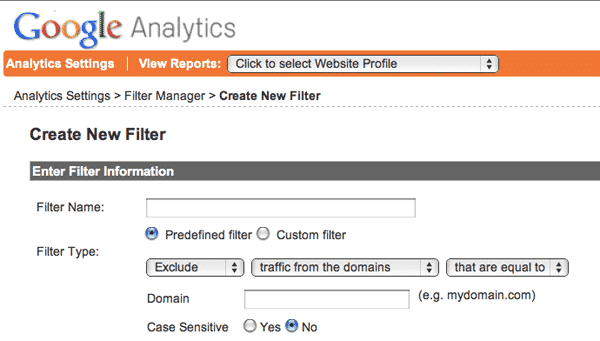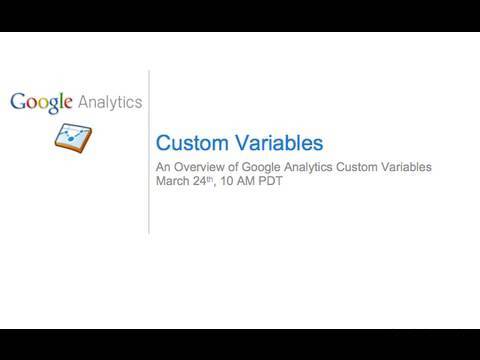Google Analytics is a fantastic tool with a lot of functionality but many webmasters don’t get the most out of their Google Analytics account. Kind of like we don’t use all of our brain, you may not be using all of the Google Analytics’ functions. Here are 9 Google Analytics features you aren’t using but should be. As an added note, if you aren’t using Google Analytics at all, you need to sign up now and make sure you take advantage of these 9 features.
Custom Variables
According to Google, “custom variables are name-value pair tags that you can insert in your tracking code in order to refine Google Analytics tracking. With custom variables, you can define additional segments to apply to your visitors other than the ones already provided by Analytics.”
If it sounds confusing, you’re not alone. However, Google has a comprehensive document on their website that describes custom variables in more detail and also guides you in setting them up.
Learn more:
- Google Analytics Custom Variables, Part I: Why?
- Custom Variables, Part II: The Code
- Custom Variables, Part III: Slots
Advanced Table Filters
Using advanced filtering can save you time. Instead of having to wade through pages of keyword results, for example, you can filter these keywords out using several filters including bounce rate, average time on site and pages viewed per visit. Watch this video from Google to learn more about how to use advanced table filters.
Learn more:
Advanced Segmentation
Advanced Segmentation allows you to create more defined reports generated from your Google Analytics data. Google Analytics captures a lot of data and sorting through the available information can easily overwhelm novice users. Using advanced segmentation gives you more precise control of this data.
Learn more:
- Setup Google Analytics Advanced Segmentation
- What’s the difference between advanced segments and filters?
Weighted Sort
Weighted Sort is relatively new to Google Analytics. The feature provides you with another way to dig deeper into your data to obtain more actionable information. It is easy to initiate a weighted sort on your existing data, find the information you were looking for, and revert back to the standard sort.
Learn more:
- Your New BFF: Weighted Sort in Google Analytics
- Google Analytics Weighted Search is a License to Print Money
Analytics Intelligence
Google Analytics Intelligence allows you to create custom alerts based on specific events. Google Analytics Intelligence monitors your data in near real-time and can alert you when a significant event occurs, based on your preset data. You simply name the alert and then set the conditions.
For example, you can set up an alert to be notified when visitors from Phoenix post a 50% decreased time on site when compared to the previous day. Setting up the alerts is simple but it will take some tweaking to determine what type of data you want to generate an alert.
Learn more:
IP Exclusion
When monitoring your traffic data, you don’t want to count your own personal and employee visits to the site as this could skew your results. Think about how many times you, your Webmaster, web designers, etc visit your site during a big project. If you have millions of visits per month this may not make much of a difference but if you have a smaller site, these visits could overshadow your real traffic numbers. You can’t make solid website-based business decisions if you don’t know your actual traffic.

Learn more:
Stat Comparison
Google Analytics allows you to compare your existing statistics to previous data. You can compare this week’s traffic to last week’s or this even this year’s traffic to last year’s traffic. As an added bonus, you can schedule automatic comparison reports that are delivered to your inbox regularly.
There are several ways to use stat comparison to better your site but one example is figuring out what happened to keywords that once generated significant traffic for your site. If you are no longer receiving new traffic based on an important keyword, but you were at one point in the past, you can begin to focus on that keyword again. If you never bothered with stat comparisons then you wouldn’t know that you’re losing important keyword-based traffic.

Learn more:
- How do I compare different metrics or date ranges for a single report?
- Using Google Analytics to Compare Traffic from Different Periods of Time
Goals and Funnels
Google defines goals and funnels as:
Goals – A goal is a website page that serve as conversions for your site.
Funnels – A funnel represents the path that you expect visitors to take on their way to converting to the goal
Goals and funnels allow you to track specific conversions on your site. If your conversions are low, you can make the necessary changes to increase your site conversions.
Learn more:
- Google Analytics in Depth: Goals and Funnels
- What are the different goal types and how do I create each one?
AdWords Integration
If you are a Google AdWords customer, then you must integrate your AdWords account into your Google Analytics account. You will be able to better track the visits generated from your AdWords ads and get the most bang for your buck.
Learn more:
- How do I link my Google Analytics accounts to my AdWords account?
- Linking AdWords & Analytics: a Troubleshooting Guide
If you’re already a seasoned Google Analytics user, what are your favorite features?
